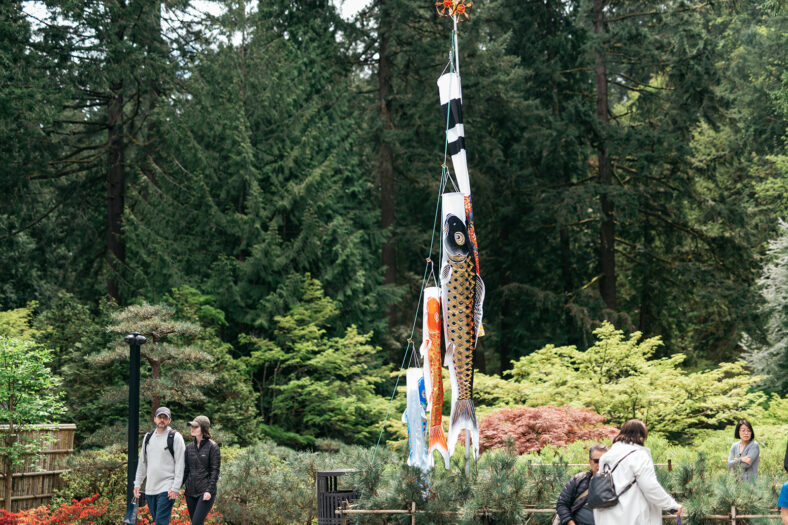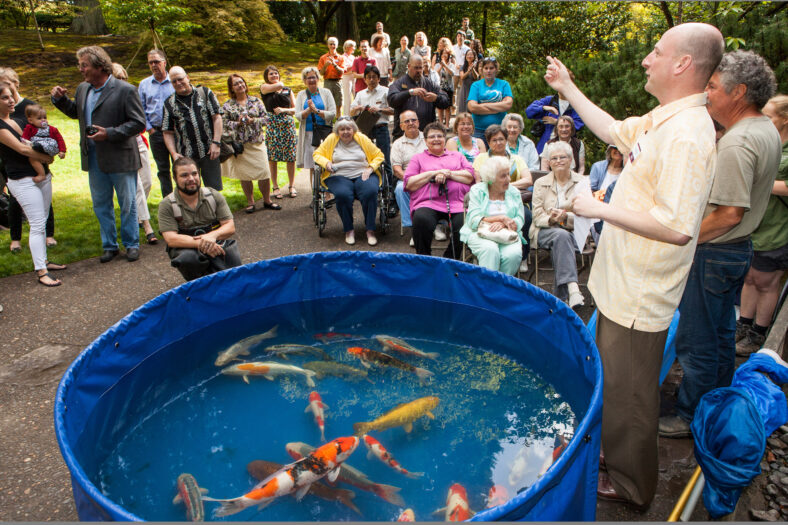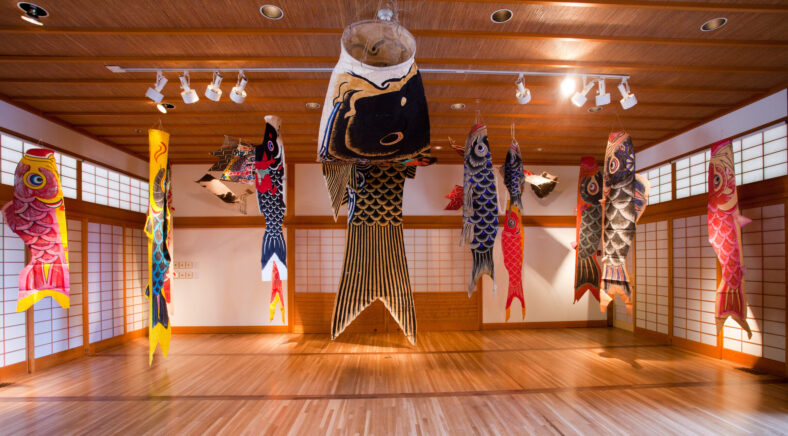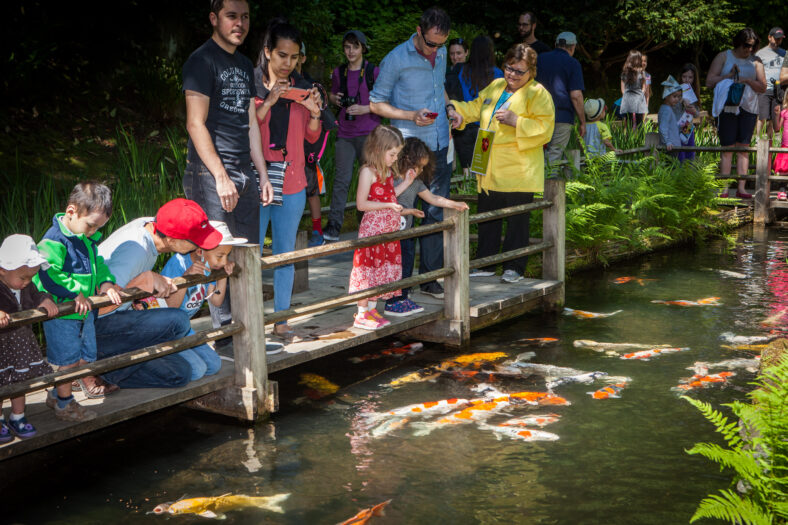
In Portland, Oregon, sunshine is often more of a memory than a presence. Yet, while overcast skies may be thought of as gloomy in some spaces, in Portland Japanese Garden this kind of weather elevates the vivid colors present throughout its grounds. On a gray May day, the azaleas and rhododendrons showcase their lush purples and pinks, moss on stone and tree limb almost looks like it’s in motion with a kinetic green. However, there may be no element of the Garden’s landscape that truly comes alive against the cloud cover than its koi.
These fish are perhaps the single greatest generator of joy here and feel as though they themselves shine a light borne from within. In summer, as sun envelops our grounds, they shine, becoming the “living jewels” so many refer to them as. Some koi with dazzling splashes of red, some in sleek golden hues, others showcasing a rich black—they delight all those who come to visit them in the Strolling Pond Garden. In honor of these beloved creatures, let’s take a look at their history at Portland Japanese Garden, their cultural significance in Japan, and answer some common questions.

The koi of Portland Japanese Garden were first introduced in the 1970s following a generous donation from Mark and Alice Sumida, a couple that raised koi in Woodburn, Oregon. In an issue of The Garden Path printed during this time, the consideration put into the addition of these creatures was described:
“After many years of careful study, much introspection, and some misgivings, we have added koi to our ponds. We accumulated as much information as we possibly could regarding water conditions, feeding, freezing weather, cleaning of the ponds, and diseases of koi before embarking on the project. In the last analysis, we have concluded that the best way to learn is by doing.”
WATCH: Children Get Their Koi Questions Answered by Experts
Koi, a distinct species from goldfish, used to traipse in some of the other waters of Portland Japanese Garden, but to help keep a more watchful eye, they were corralled into the lower pond of the Strolling Pond Garden. This is not the first time this part of the landscape has been home to animals on display. Prior to the Garden’s establishment in 1963, the grounds it operates in today used to be the old Portland Zoo—the area where koi swim was once a concrete bear pit. One would think these ursine creatures would have likely preferred the leafy and verdant space the fish enjoy today.

While the Garden has literal koi swimming in the Strolling Pond Garden, one can also find it symbolically represented in other spaces. In the Natural Garden, one stone stands out in the first pond. Humpbacked and jutting out from the water, it resembles a fish swimming upstream—this is the carp stone, symbolizing a tale originating in Chinese folklore of a carp that passed through the Dragon Gate on the Yellow River and turned into a dragon—a story that suggests even an “ordinary fish” might become “mighty” (Hayes, 1923).

In May, as the Garden celebrates Kodomo no Hi, or Children’s Day, one can also see cloth koi swimming through breeze as koinobori, or carp streamers. From April to early May, koinobori are flown outside of homes and public buildings in Japan and are thought to symbolize courage and strength, tying back to the story of the Dragon Gate.

Improvements Made to Protect the Koi

The early 2000s would mark a bleak period for the Garden’s koi with winter storms and unforeseen viruses taking a toll. Under the leadership of CEO Steve Bloom (2005-present) and then-Garden Curator Sadafumi Uchiyama (2008-21; Chief Curator, 2021-23), a major campaign was launched in 2010 to improve their environs. Bloom wrote in the February 2011 edition of The Garden Path:
“We began the first phase of restoring our population by renovating the koi habitats. We’re improving the water quality in the ponds with new filtration systems, deepening the ponds (the Lower Pond will be three feet deeper), and sealing cracks and seams to reduce water leakage and keep the pond depth more stable. We’ve also replaced the Zig-Zag Bridge and its foundation that rests in the pond. Our next task is to raise money to repopulate the koi themselves. It’s a significant investment for the Garden as the fish cost an average of nearly $1,400 each, but obviously a worthy one.”

As part of this effort to restore the koi to Portland Japanese Garden, then-Curator of Culture, Art, and Education Diane Durston led the 2011 exhibition, Come Back Koi! The show featured original woodblock prints of koi by Tokyo artist Kunio Kaneko, an array of 19th and early 20th century koinobori and nobori-bata festival banners, and a selection of handmade kites by Mikio Toki, Nobuhiko Yoshizumi, Greg Kono and Scott Skinner from the Drachen Foundation of Seattle.

Over the next few years, new koi were introduced to the pond after repairs had been made. Former Senior Gardener Adam Hart wrote in the July 2013 edition of The Garden Path:
We have a first-rate filtration system taking care of all gallons of pond water. Skimmers are installed along pond edges to remove large debris from the water’s surface. Biological filters house a colony of beneficial bacteria which are constantly working to clean unwanted material from the pond water. Additionally, there is an ultraviolet light that water passes by on the way to the Heavenly Falls which serves to keep any algae from growing in the ponds.
The organization also invested in an improved holding facility for the koi, so that new fish could be quarantined or to hold any koi under the weather. “To keep the koi healthy, we needed a dedicated safe place to take them out of the pond and doctor them on occasion. That’s why the holding tank has been integral,” said Hart in 2018. “We want to give them the best care possible. They are a part of our Garden, just like the plants and stones.”
The dedication of Portland Japanese Garden’s leadership in improving conditions for the koi combined with the staff’s affinity for them helped mitigate the impacts of the 2024 winter storm that waylaid much of Portland. “Our staff worked to make sure the koi were receiving fresh oxygen aerated into their pond water,” explained Director of Operations Jason Sipe in January of that year. “We had to make sure the pumps were running at all times and even use breaker bars to prevent the water from freezing solid. This meant physically being present at the pond and keeping the generators fueled and oiled as the ice worsened and power outages persisted.”
Caring for Koi

While the friendlier and more technologically-advanced confines have done much to help stave off critical concerns for the koi, Portland Japanese Garden’s staff is still diligent in caring for them today. The koi, most of which are purchased and imported from Japan, are fed based on the temperature of the water and the season. In spring they may be fed once per day, but they might gets as many as six feedings per day during the height of summer: meals of specially tailored pellets and the occasional fruits or vegetables as a treat.
It’s during winter that the feedings and all-around activity of the koi mellows. If one looks into the waters of the lower pond in the Strolling Pond Garden, they’ll notice a pit that goes eight feet deep. It is in this space that the koi will often spend most of their time in winter, in a hibernation-like state called torpor. Those that are not quite resilient enough against the cold are kept in heated holding tanks.

Another element of how the koi are cared for is through our guests. Portland Japanese Garden is grateful for those who refrain from touching the koi, feeding them, or tossing alien objects into their waters. More so than bad weather or the rare predator, it is human interaction that poses the greatest risk to the wellbeing of the Garden’s koi today—our hands can inadvertently pass on illnesses or damage the membrane that coats their scales.
The Cultural Importance of Koi

While the mention of koi brings immediate visions of dynamic oranges, reds, and yellows, the word koi itself in Japanese simply means “carp,” referring to the species as a whole. The true origins of where today’s carp hail from is still a matter of debate among researchers in the field (Britannica, 2023), but some fossil data suggests that the ancestors of the today’s common carp swam in the waters of Japan’s Lake Biwa millions of years ago (Kohlmann, 2015). What does appear to be known is that in as early as the Heian period (794-1185), breeding of ornamental carp was enjoyed by Japan’s aristocracy (Kodama, n.d.). Later in the 1780s, farmers of what is today is known as Niigata Prefecture were rearing three variants of koi as a food source, including magoi (true carp). It was from these magoi that the radiant fish like those enjoyed at Portland Japanese Garden descend from: Nishikigoi, or “brocaded koi” (de Kock & Gomelsky, 2015). Because of their mesmerizing beauty and engaging personality, these kinds of koi today are rarely seen as a food source for people.

Among the many outstanding qualities of Japan has been the capacity of its people to transform the utilitarian into the exquisite. Stone lanterns and netsuke (miniature carvings used as toggles for kimonos) are but just a few outputs that started plain and evolved into an avenue for artistic mastery. Nishikigoi are yet another example. Koi farmer and writer Servaas de Kock and fish geneticist Boris Gomelsky note that explanations as to why this one particular region of Japan would be the birthplace of Nishikigoi borders on the “mystic,” but suggest that drought and famine during the nation’s Tenmei era (1781-89) that reduced the gene pool of the carp, the occurrence of genetic mutations, and human curiosity are likely reasons for the proliferation of these swimming jewels, noting, “according to local memory, it was shortly after this that colored aberrations appeared” (de Kock & Gomelsky, 2015).
Among the many different kinds of Nishikigoi, three in particular have become so exceedingly popular that they have been deemed Gosanke, a term used throughout Japan to connote when a trio of any sort is thought of as a “big three.” The term itself originates with the three most honored houses of the Tokugawa Shogunate during the Edo Period (1603-1868): Owai, Kii, and Mito (“Gosanke”, 1993). The Gosanke of brocaded carp are Kohaku (mostly white with red flourishes), Taisho sanshoku (white with red flourishes and black accents), and Showa sanshoku (white with red flourishes and more prominent black splashes than the Taisho) (Knight, 2022).

While the appreciation of Nishikigoi dates back centuries in Japan, it wouldn’t be until the 20th century that they reached a global audience when they were featured at the 1914 Tokyo Taisho Exhibition in Ueno Park, where they were marketed as kawarigoi, “unusual carp” (Nippon.com, 2021a). Their mesmerizing beauty captured the attention of many, leading to an “explosive growth of koi hobbyists and overseas exports” (Knight, 2022). Among those captivated was then-Crown Prince Hirohito (posthumously, Emperor Showa), who had some brought to the Imperial Palace. Today, Nishikigoi are still highly important to Japan’s government—the Japanese Agricultural Standards have named and defined 21 varieties of the brocaded carp and it’s considered a “critical export item” (All Japan Nishikigoi Promotion Association, n.d.).
When those of Japanese ancestry moved to the United States, their love of koi arrived with them. As has been the case with gardens built at concentration camps during WWII, some of the wrongly incarcerated residents even built koi ponds. Jack Hanshiro Arai (Issei, or first-generation Japanese immigrant), was a Los Angeles resident who was forced into Manzanar War Relocation Center in California. Next to a small garden that grew chrysanthemums, green onions, and nasubi (eggplant), he built a pond and filled it with koi. His daughter Madelon Arai Yamamoto noted in a piece published by the U.S. National Park Service: “We had benches all the way around. My father built the benches so that we could sit and people that came to look at the koi pond could also sit and reflect.” (Burton et. al, 2014).
Understanding Koi Through Their Senses

In 2013, Linda Montgomery, a koi expert that has consulted with Portland Japanese Garden for many years, answered these often-asked questions about the carp in The Garden Path.
Q: Why do koi have whiskers?
A: Those whiskers are called barbels and koi have them to help taste. In a way they are similar to your tongue as they have taste buds on them. Many, many years ago koi had three barbels, but now they only have two. Koi also have taste buds on their mouth and lips, so they have an excellent sense of taste.
Q: Do they have a sense of smell?
A: Koi do have a very good sense of smell. Their extremely acute sense of smell and their sense of taste are their primary senses in finding food in their natural environment. When food dissolves in water it can then be detected by their nose by the ‘nares’ that are located at the base of their nostrils. The nares can be thought of as U-tubes, as the water enters through the forward opening and exits through the rear opening. Water does not flow to any other part of the body from the nares.

Q: Do the koi hear?
A: Yes, koi do hear even though they have no external ears. This is accomplished by the koi sensing vibrations in the water. Koi hear with what is called the Weberian Ossicles, a group of bones that are connected on one end to the forward swim bladder and on the other end to the auditory center, a sensing organ that resembles our inner ear. Koi, like other fish, are very sensitive to sound and can be stressed to the point of becoming ill by loud noises, especially on a constantly recurring basis.
Q: Do koi see very well?
A: Koi see exceptionally well. They have such good sight they could probably even read a book. They actually have a greater range of vision than we do, as they have bilaterally placed eyes that are independently moveable. They also see color and black and white. The eyes of the koi are more vulnerable than our eyes because they do not have eyelids; so, great care must be taken when they are netted and handled.

Q: Do koi have the sense of touch?
A: Yes, and the most sensitive area for this sense is located about midway down the side of the fish called the lateral line. Holes in the scales lead to a canal beneath the surface that contain neuromast cells. Water movement in any direction striking the sides of the fish will cause the mucous in the canal to vibrate. These vibrations stimulate the cells that are linked to the nerve system and provide koi with one of the most effective survival techniques (flight reaction).
Written by Will Lerner, Communications Manager for Portland Japanese Garden and Japan Institute.
Works Cited

All Japan Nishikigoi Promotion Association. (n.d.) The birth and history of Nishikigoi. https://jnpa.info/en/nishikigoi/history/
Burton, J.F., Farrell, M.M., Brasfield, E., Noguchi, E., Potashin, R., & Wai Ng, L. (2014). A place of beauty and serenity: Excavation and restoration of the Arai family fish pond, block 33 barracks 4. National Park Service, U.S. Department of Interior.
Britanica. (2023, October 13). Koi. Encyclopedia Britannica. https://www.britannica.com/animal/koi-fish
de Kock, S. & Gomelsky, B. (2015). Japanese ornamental koi carp: Origin, variation, and genetics. In C. Pietsch & P.E. Hirsch (Eds.), Biology and ecology of carp. (pp. 3-26). CRC Press.
Gosanke. (1993). In A. Campbell & D.S. Noble (Eds.), Japan: An illustrated encyclopedia (Vol. 1, p. 467). Kodansha Ltd.
Hayes, L.N. (1923). The Chinese dragon. Commercial Press Limited.
Knight, L. (2022). Crazy for koi: Dive into the origins of Japan’s living artworks. Tokyo Weekender. https://www.tokyoweekender.com/art_and_culture/japanese-culture/japan-koi-fish-history/
Kodama, T. (n.d.) What is a Nishikigoi? Koi fish history explained and meaning. Kodama Koi Farm. https://www.kodamakoifarm.com/what-is-nishikigoi-history-meaning/
Kohlmann, K. (2015). The natural history of common carp and common carp genetics. In C. Pietsch & P.E. Hirsch (Eds.), Biology and ecology of carp. (pp. 27-53). CRC Press.
Nippon.com (2021a, April 23). “Nishikigoi”: Niigata’s swimming treasures. https://www.nippon.com/en/guide-to-japan/gu900176/?cx_recs_click=true Nippon.com. (2021b, April 30). “Nishikigoi”: Rekindling domestic interest in Niigata’s iconic ornamental fish. https://www.nippon.com/en/guide-to-japan/gu900177/?cx_recs_click=true